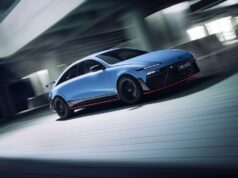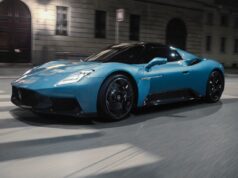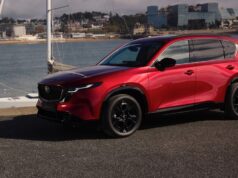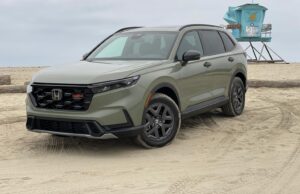The SUV/ crossover segment continues its takeover of the auto industry, which started with larger models, like the Ford Explorer, then it moved slightly down size with models like the Honda CR-V and Toyota RAV4. Now the biggest growth is in the compact crossover class, which is quickly becoming so crowded with the Honda HR-V, Mazda CX-3, Jeep Renegade, and countless other models.
Toyota basically launched the crossover segment with the help of the Honda CR-V in the mid-1990s and now that the RAV4 has grown into adulthood, there’s room for another small model to fill its once compact shoes – the C-HR. The 2018 Toyota C-HR, yes another confusing name that will be hard to differentiate from the CR-V name, was destined to breathe some life into the Scion brand, but at the 11th hour, Scion was axed and a Toyota badge was stamped on the hood instead.
Does the C-HR have what it takes to compete with the Honda HR-V? Here are the five things that I was left with after my week with the cute-ute.
1. Is the C-HR really a crossover or just a slightly taller hatchback?
The same question can be asked of many crossovers, but it’s slightly harder to answer with the C-HR. Why? For starters, the C-HR doesn’t offer all-wheel drive. Yup. The availability of all-wheel drive has always been a given in the SUV/ crossover segment, but Toyota is bucking the trend, since the C-HR will only send its power to the front wheels.
Next, parking between the run of the mill sedan, the C-HR really doesn’t have much more ground clearance over a regular compact sedan or hatchback. To compare, the C-HR only has 5.9-inches of ground clearance compared to the Corolla’s 6.7-inches. This was further proven by a coworker, who is in the market for a small SUV, but was easily turned off by how un-SUV the overall height of the C-HR is. The C-HR is 61.6-inches tall, while the Honda HR-V is 63.2-inches tall.
Being that I love hatchbacks, it was easy for me to get based this dilemma, but if you want something that feels more like an SUV than a car (ride height, all-wheel drive, better cargo space), then you’ll want to look elsewhere.
2. The C-HR meets expectations, but doesn’t try hard to exceed them
With the HR-V you get the amazing cargo space (21.2 cubic feet more) and Magic second row seat to give you more cargo carrying capacity than you’d expect. The Nissan Juke offers a fun turbocharged engine, to add a little sport in the segment. The Jeep Renegade, takes the rugged styling of the iconic Wrangler to give it a more masculine exterior, that’s largely missing in this segment.
What does the 2018 C-HR do that stands out? It’s comfortable to drive, the interior is quiet and its styling does stand out a little more than the HR-V. Are these things enough? Not really. The C-HR is a competent crossover, but at the end of the day, it’s not very memorable.
3. Some tech features are great, some not so much
The C-HR comes standard with the latest safety features, like Lane Departure Alert with Steering Assist, Full-Speed Range Dynamic Radar Cruise Control and a Pre-Collision System with Pedestrian Detection. Those things are all great in this segment. Driving in traffic, I’d set the auto cruise control to a speed and it would maintain it and even bring the itself to a full stop. It made my tedious commute, much less tedious.
What’s lacking? For starters, why is the backup camera displayed in the rear view mirror? It’s almost like the feature was an after thought when Toyota’s team was deciding on how to equip the C-HR. The display isn’t very clear and it’s tiny. You’ll pretty much just give up on using it and act like you don’t even have a backup camera.
Why does Toyota hate Apple CarPlay and Android Auto? Toyota is one of the last mainstream automakers that don’t offer the connectivity. Yes both systems do have some issues, but they are more convenient and user friendly than the C-HR’s infotainment system.
4. The C-HR isn’t boring
For years Toyota has tried to rid itself from the stigma that all its cars were boring appliances. While there are still some boring models in the lineup, like the Corolla, the C-HR bucks the trend. Maybe it has to do with the fact that the C-HR was originally supposed to be a fun Scion crossover, but either way the C-HR with its bold exterior is a welcome change. From its coupe-like roofline to its wedge-shaped rear and slightly bug-like headlights, the C-HR drew many comparisons to the Nissan Juke for its out of the box design.
On the road, the C-HR continues its more emotional mission. It’s suspension swallows the road’s imperfections with ease, but also when the road gets a bit twisty, the C-HR is ready. There’s minimal body roll and even a bit of feedback from the steering wheel. The overall setup is quite nimble and would be even more fun if the C-HR wasn’t let down by its underwhelming engine. The C-HR is powered by a 2.0L four-cylinder engine that generates 144 horsepower and 139 lb-ft. of torque, which is on par with other models in the segment. The four-cylinder is only available with a CVT transmission in the US, which tries to help, but a manual transmission would do a lot here.
5. The C-HR is a good start, but with a few additions, it could be great
The C-HR’s nimble handling and quirky styling help it stand out, but with the addition of a small turbocharged engine, the C-HR could be great. A turbocharged engine would give the C-HR what it needs to rival models, like the Nissan Juke and Kia Soul Turbo. Most buyers probably don’t need it, but the addition of all-wheel drive would make it feel like it really is more of a crossover than simply a slightly taller hatchback. Lastly updates to the infotainment system, optional leather seats and maybe even a sunroof would go a long way in improving the overall package.
At the end of the day, even though Toyota took longer than most automakers to enter the segment, the C-HR is a competent crossover in a crowded segment.
Pricing for the 2018 Toyota C-HR starts at $22,500 and it is offered in two trim levels: XLE and XLE Premium. Both versions are powered by the same 2.0L engine and have a fuel economy rating of 27/31 mpg.





























